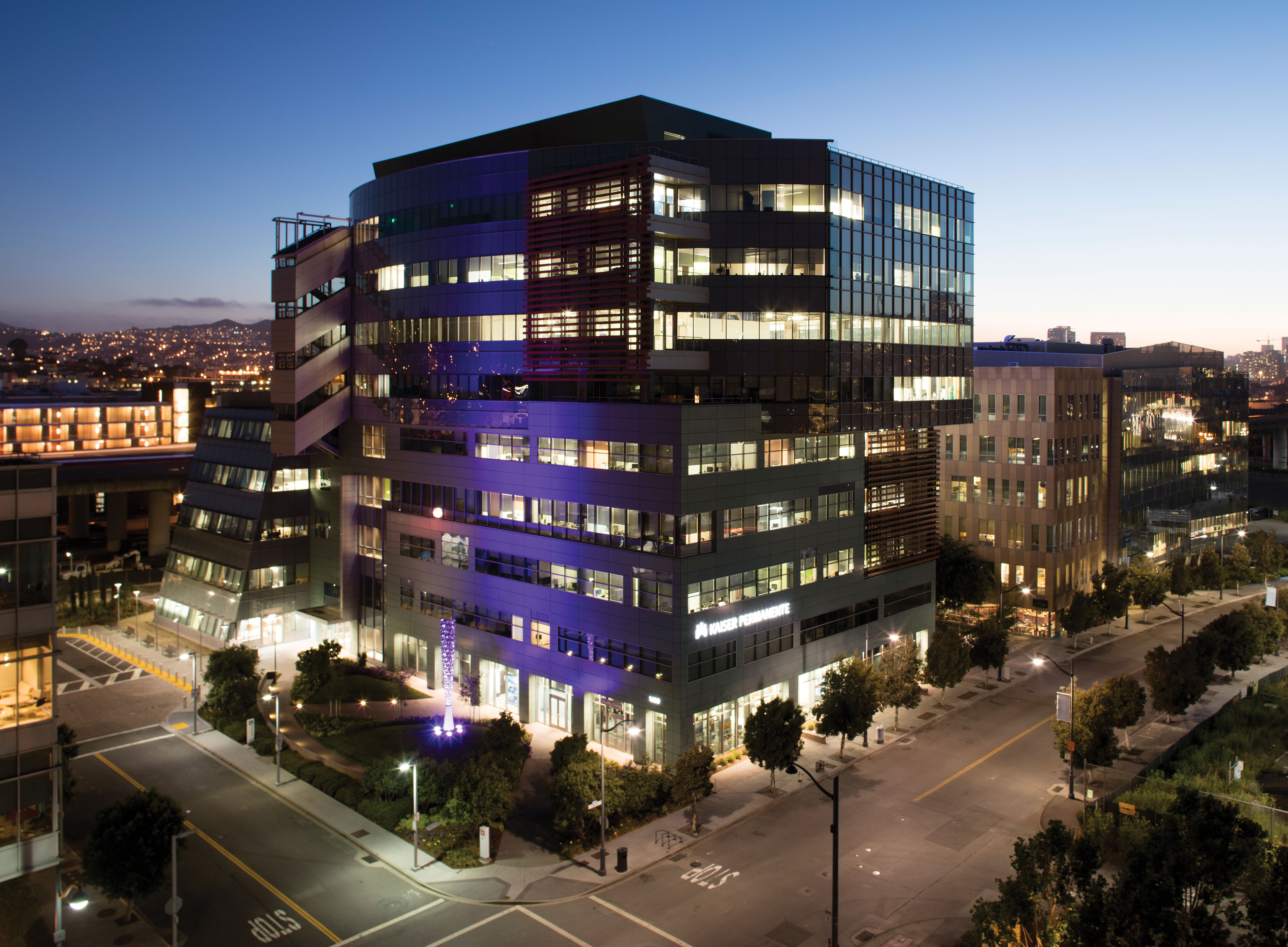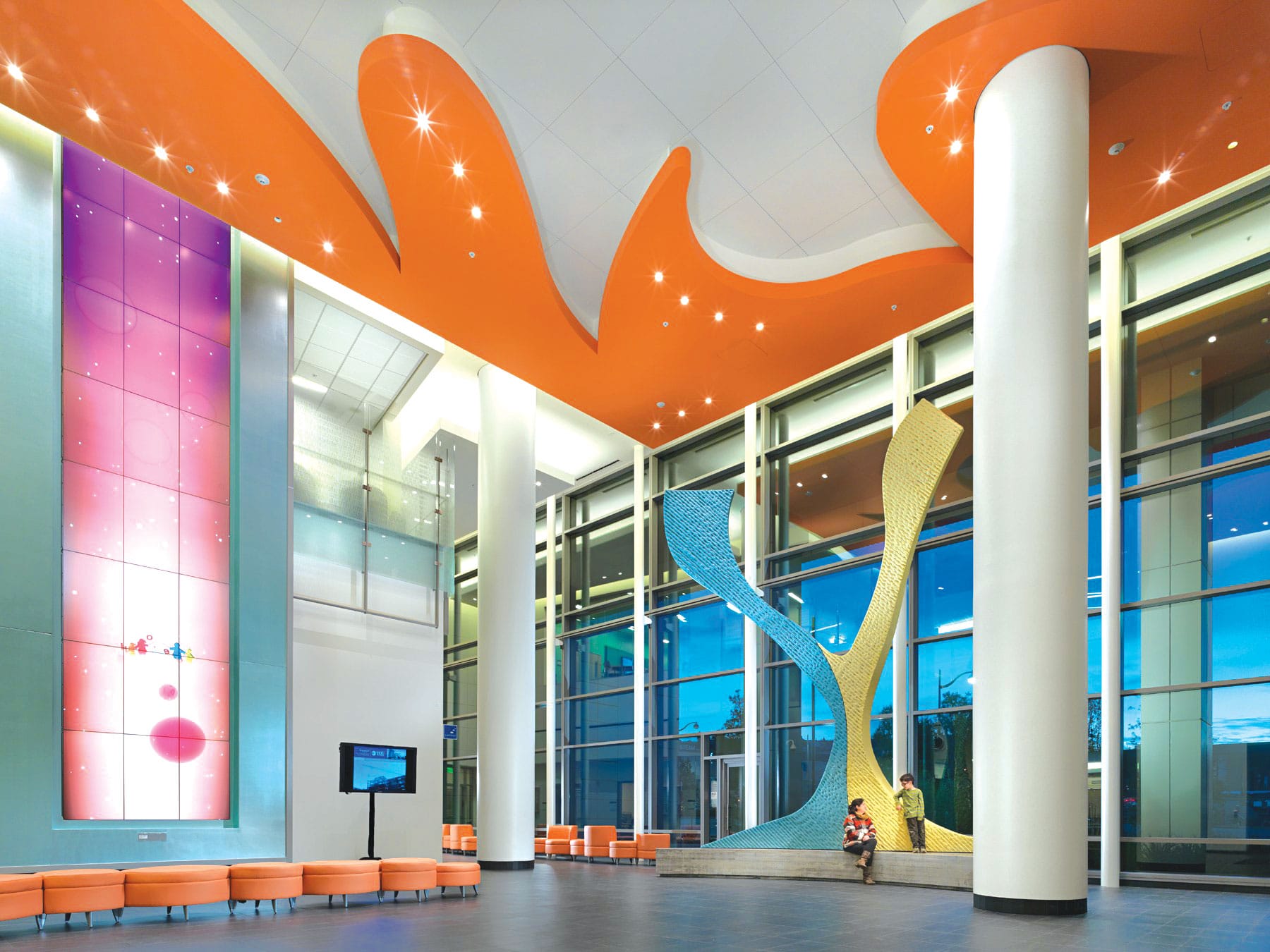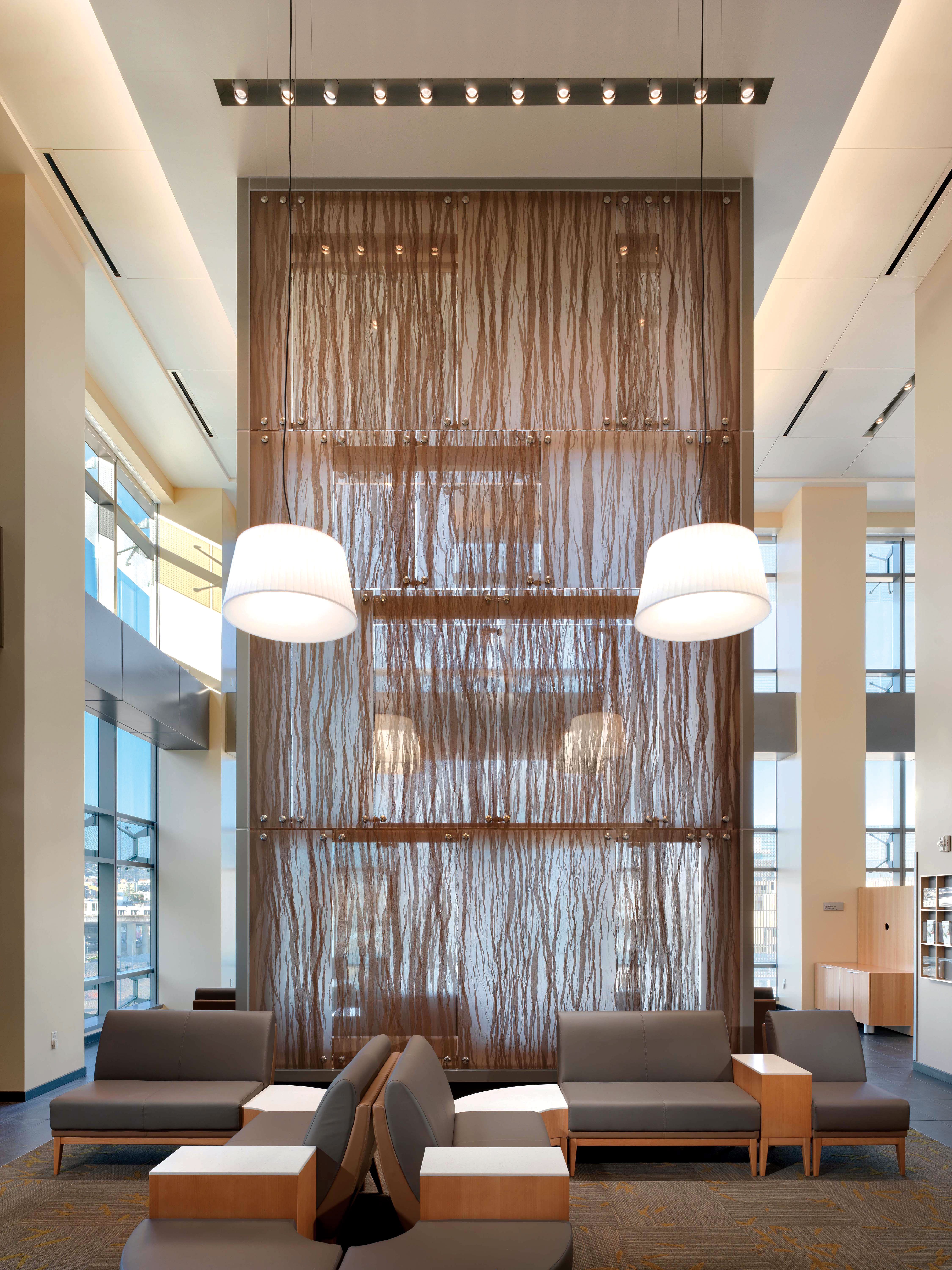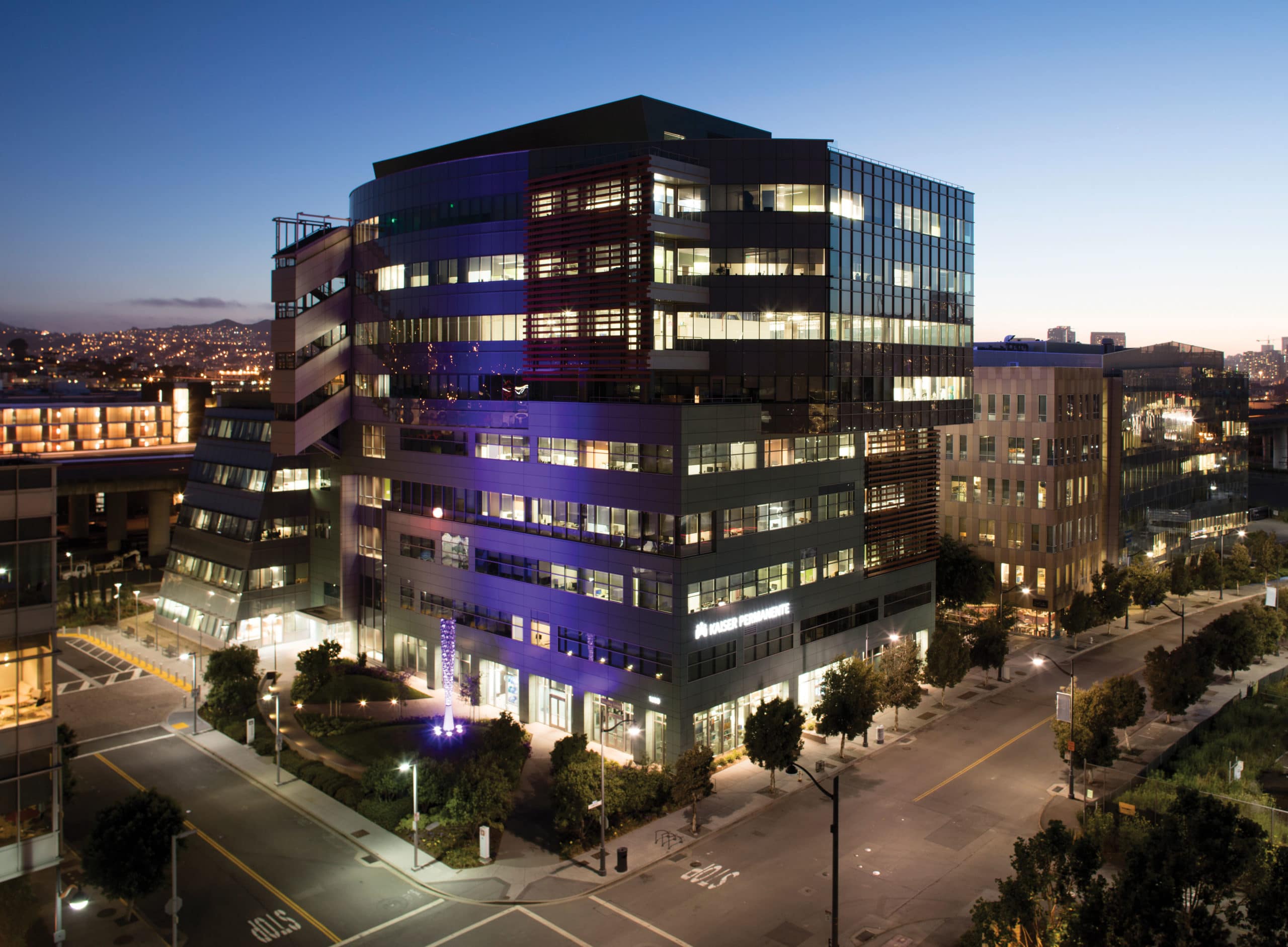Hint: Think of it like a home.

90% of the occupied spaces at Kaiser Permanente’s Mission Bay Medical Office Building have natural daylight, which saves energy and money, but has also been shown to encourage healing and well-being. [Photo: Courtesy of Kaiser Permanente]
Architect Laurel Harrison is very at home in hospitals. Literally. Her dad was a physician, her mom a nurse, and nearly every aunt, uncle, cousin, and grandparent in her family worked in health care in some capacity. As a child, she spent many hours hanging out in her father’s waiting room, reading books and imagining that one day when she grew up, she too would tend to patients, combining TLC with medical expertise to improve the lives of those who are ailing. Most of that vision has come true, except Harrison now uses design expertise, not medical expertise, to help those in need of healing.
“Hospitals are a place where people are incredibly stressed and going through what may be the worst thing that will happen to them in their lives,” says Harrison, now a senior principal at Stantec’s San Francisco office and the health care sector leader for the company’s West Coast operations. “We need to build them in a way that makes people feel better, safer, cared for, and less stressed. It was a real ‘aha’ moment when I realized I could influence that through design. It’s something I feel very passionate about because of how I grew up—but it’s an incredible challenge.”
It’s a challenge that Harrison has been picking apart throughout her career, but in 2015 a milestone arrived: the $1.5 billion UCSF Medical Center at Mission Bay, one of the largest and most innovative new medical facilities in the country, opened its doors after 10 years of planning, design, and construction. Located on a 14.5-acre site along the eastern edge of San Francisco, where it overlooks the magnificent San Francisco Bay, this 289-bed, 878,000-square-foot LEED Gold complex is comprised of three distinct facilities: a children’s hospital, a woman’s hospital, and a cancer hospital, all of which are part of UCSF’s research network.
Harrison, who was the project director, says UCSF gave the design team a “real mandate around health and sustainability … so the project wasn’t just about engineering sustainability in the building, but about building a healthy environment in every aspect of the word.”

The UCSF Medical Center at Mission Bay includes a bright and cheerful children’s hospital lobby full of natural light. [Photo: Courtesy of Stantec]
Why Hospitals Sometimes Make Us Sicker
Gary Cohen, president and co-founder of Health Care Without Harm, says the leading source for patient harm in hospitals is “hospital acquired infections,” also known as HAIs, which impact upwards of 2 million patients per year in the U.S. The biggest culprit in his view? Shared patient rooms, rather than single occupancy spaces. Newer, cutting-edge hospitals are being designed to have much more natural light, and a quieter, more soothing environment, which single occupant rooms help to ensure. “It has only been recently that research has validated what patients have been saying for decades, which is that the noise in hospitals prevents restful sleep and disturbs the healing process,” Cohen says.
Such features typically cost more up front, but Cohen’s analysis is that they more than pay for themselves in the long run. “The financial decision-makers in hospitals are often engineering out these more high-quality spaces in their facilities. But we need to move beyond upfront costs to evaluate the long term ROI. If you factor in reduced HAIs and faster patient recovery, it pencils out.”

The UCSF Medical Center is a LEED Gold complex with children’s, women’s and cancer hospitals. [Photo: Courtesy of Stantec]
Another huge issue: toxic chemicals in both medical products and hospital furnishings and finishes. Cohen says PVC-based blood bags, for example, leach DEHP (a reproductive toxin) into patients. Safer alternatives are nearing commercialization in Europe, paving the way for them to enter the U.S. market. Every year, more and more nontoxic materials enter the health care industry supply chain, and Cohen is seeking to spark a cultural shift within the industry to encourage their adoption.
“There are many alternatives on the market,” he says. “But Group Purchasing Organizations have done little to promote them. Often, if they do put them on a contract, they also put the ‘brown product’ on the contract as well, which often costs less. So we need to incentivize the market for safer alternatives.” Green Health Exchange, a new purchasing cooperative, spearheaded by Health Care Without Harm, is working to do just that. As production scales up, the safer products are becoming more affordable, sometimes more so than the older, more toxic products.
10 Qualities of a Healthy Health Care Environment
Gary Cohen, president and co-founder of Health Care Without Harm, believes that scaling up eco-friendly and nontoxic product lines is one of the most effective means to building a healthier health care industry. That’s why he’s worked very hard for the last several years to develop the Green Health Exchange, a purchasing cooperative that now counts more than a half-dozen major health care systems in its membership.
“We’ve come to the conclusion that if we can aggregate the purchasing power of all these hospitals we would accelerate market transformation toward safer products a lot faster,” Cohen says. “We’re saying to suppliers, if you want to buy from us, you have to disclose what is in your products. They can’t afford to turn down a $10 or $20 million contract because they didn’t share what chemicals they use. It’s become a powerful lever for transformation.”
Green Health Exchange is still in its infancy, but it’s already driving down prices for better quality products and materials. Cohen says flame retardant–free furnishings have suddenly become cheaper than those with toxic flame retardants. “How absurd is that?” he says. “You actually have to pay extra to be poisoned. We’ve stimulated the other big purchasers in the sector to start beefing up their own sustainability staff. They realize there is a real competitor on the market now, so they’re paying attention.” Cohen suggests 10 ways health care facilities can become better models of health and well-being:
1. Maximize natural light.
“People feel better, use less medication, heal quicker, and leave the hospital sooner under natural light.”
2. Exposure to nature.
“It’s intuitive, but there’s actually research that suggests views of nature help people heal quicker.”
3. Minimize noise.
“When there’s lots of bells and whistles and noises and machines going on, it’s very disturbing, especially for patients’ sleep.”
4. Provide individual patient rooms.
“Research shows that individual patient rooms are preferable for reducing hospital acquired infections—they also make it easier for family members to stay with their relatives who are undergoing treatment.”
5. Lose the institutional vibe.
“Making hospitals feel like less of an industrial place, and more welcoming, is really important.”
6. Serve healthy food.
“Providing healthy, sustainably produced food supports healing and models healthy habits for patients, workers, and visitors.”
7. Eliminate toxins.
“It’s a no-brainer at this point. Many of the nontoxic alternative products are now cost competitive or even cheaper.”
8. Use greener cleaners.
“Some older cleaners and disinfectants contain chemicals that are asthma triggers. It’s time to detoxify hospital environments so they actually promote healing rather than contribute to disease.”
9. Install “smarter” lighting.
“There are new kinds of lighting that stimulate melatonin production at night, so you can sleep better, and stimulate cortisol during the day to keep people more alert. For patients, it encourages a schedule that promotes rest.”
10. Expose stairwells.
“If people can see the stairs, they are more likely to use them, rather than opt for the elevator.”
Environment & Human-Friendly
The UCSF Medical Center embodies much of Cohen’s vision for what a healthier hospital looks like. A few aspects of its environmentally friendly features are also worth noting. For starters, the facility is designed to use 50% less energy than the average U.S. hospital. Water conservation strategies at the site are expected to save 4 million gallons per year. And 90% of construction waste was recycled, rather than sent to the landfill. You’ll also find 10 electric vehicle charging stations in the parking deck.
The center is also green in a literal sense—with 4.3 acres of landscaped gardens, including 1 acre of rooftop gardens—which is where Harrison says the features for environmental health begin to overlap with those intended to support human health and healing. The ground-level gardens, for example, are a boon to employees and visitors, who can soak up the sun and meditate on the birds, butterflies, and bees buzzing around the native plantings as a reprieve from the heavy reality indoors.
Many hospitals these days, especially those in more spacious suburban settings, have incorporated such “healing gardens,” but what about the patients who are not well enough to venture out of their room, down the elevator, and out into public space? This is where the center’s terrace gardens—located on three extensive roof decks adjacent to floors where inpatient rooms are located—come into play. Patients who are in the hospital for an extended period have easy access to a quiet, inviting outdoor space. And for those who are too ill to visit one of the terrace gardens, each inpatient room has what Harrison calls a “sky porch,” a balcony where patients can drink in the fresh air, feel the sun on their skin, and take in the view—most of the balconies overlook the bay or the terrace gardens.
“We want people to be able to step out and see and touch the natural environment without having to go all the way through the building and back out the front door,” Harrison says. “The sky porches allow you to experience that while you’re still within the safe environment of care, which is really lovely.”
If such luxuries sound like something you’d want in your own house, it’s no accident. The center was designed to feel like a home away from home, as study after study has shown that a nurturing physical environment is an invaluable complement to medical care. This is also why natural materials and organic forms predominate in the interior design scheme for the three hospitals, along with soothing color palettes and nature-inspired artworks that are intended to create a peaceful ambience.
Ceiling tiles and flooring surfaces were chosen to absorb sound, rather than amplify it, as is often the case in more “institutional” facilities, a category in which hospitals are too often lumped that conjures up warehouses and military bases more than a place to heal. Here and there are tiny meditation rooms with soft music, and lounges designed with faux fireplaces and other features reminiscent of a family room. Speaking of family, all inpatient rooms have sufficient space and furnishings to allow family members to stay with their relatives while they receive care, which unfortunately is not the norm at other health care facilities.
“The center has health—in the most global sense—at its heart,” says Harrison.
![Kaiser Permanente’s Mission Bay Medical Office Building employs 70,000 square feet of PVC-free flooring, like in this clinical lab. [Photo: Courtesy of Kaiser Permanente]](https://gbdmagazine.com/wp-content/uploads/2017/02/Healthy_Hospital_Mission_Bay_8_GBD43.jpg)
Kaiser Permanente’s Mission Bay Medical Office Building employs 70,000 square feet of PVC-free flooring, like in this clinical lab. [Photo: Courtesy of Kaiser Permanente]
Kaiser Permanente Raises the Bar
Just a few blocks away from the UCSF Medical Center is another new medical facility that’s raising the bar on healthy health care design. Kaiser Permanente’s Mission Bay Medical Office Building, which opened in March of 2016, is the health care giant’s most ambitious facility to date, in terms of sustainable design.
The nine-story, 220,000-square-foot LEED Platinum building houses a variety of outpatient services, ranging from dermatology to physical therapy to health education. It is also home to a number of sustainability features, including a verdant green roof that acts as a sponge slowing down storm water runoff and provides habitat for birds and beneficial insects. All of the lighting is LED, resulting in energy savings more than 30% above LEED standards. A system of “purple pipes” waits behind the walls for the city of San Francisco’s soon-to-be-completed non-potable water reclamation program, infrastructure that will be tied to the center’s bathroom plumbing and used to flush toilets.
But as with the UCSF facility up the street, Kaiser Permanente’s Mission Bay facility is a case study in healthy health care design. For example, 90% of the occupied spaces have natural daylight, which saves energy and money, but has also been shown to encourage healing and well-being. Also important to occupant health and comfort are the sensors installed in ceilings throughout the building that monitor temperature and carbon dioxide, communicating with the HVAC system to constantly fine-tune airflow—100% of which flows in fresh from outdoors.
Jay Murphy, the San Francisco team manager for Kaiser Permanente’s national facilities services department, notes that many of these features impact occupants without them even realizing it, but there is one unique aspect of the facility that gets constant attention: its artwork. Thematic pieces relevant to each department in the building were chosen from a group of over 30 local artists commissioned by Kaiser Permanente.
“For example, in pediatrics the artwork is fun and playful,” Murphy says. “It’s hard to describe, it’s one of those things you just have to experience …[but] we really thought about how people would feel when they walked in and saw the art. And what I’m hearing is that everybody notices the art, that it makes them feel good, makes them happy. That’s good, because that’s what we’re trying to do.”
![Kaiser Permanente’s sustainability scorecard requires suppliers to provide information on their company’s environmental commitment, use of potentially harmful chemicals in their products, and information about product and packaging recycling. [Photo: Courtesy of Kaiser Permanente]](https://gbdmagazine.com/wp-content/uploads/2017/02/Healthy_Hospital_Mission_Bay_7_GBD43.jpg)
Kaiser Permanente’s sustainability scorecard requires suppliers to provide information on their company’s environmental commitment, use of potentially harmful chemicals in their products, and information about product and packaging recycling. [Photo: Courtesy of Kaiser Permanente]
By the Numbers: UCSF Medical Center at Mission Bay, San Francisco
10 years time it took to plan, design, and build the facility
$1.5 billion total project cost
878,000 total facility size in square feet
3 number of hospitals within the center
50% amount of energy use per year compared to the average hospital in the US
4 million gallons saved per year as a result of water conservation strategies
90% amount of construction waste recycled
10 number of electric vehicle charging stations in the parking deck
4.3 acres of landscaped gardens
Preventing Illness with Nontoxic Materials
If improving occupant experience is one half of the equation of healthy health care design, the other is weeding out anything in the space that could actually make people sicker. Kaiser Permanente’s Mission Bay facility employs 70,000 square feet of PVC-free flooring and contains low or no emissions carpeting throughout. But the focus on sourcing nontoxic materials extends throughout the organization’s health care network.
“We have ambitious goals and standards for product sourcing, including eliminating chemicals of concern in fabrics, finishes and furniture, as well as in our medical products,” says Hilary Costa, a senior communications consultant
at Kaiser Permanente’s Oakland headquarters.
Costa is referring, in part, to the organization’s 2025 Environmental Stewardship Goals, one of which is to increase the purchasing of safer products and materials by 50%. But it’s an effort that’s been underway for quite some time. In 2010, Kaiser Permanente developed its own “sustainability scorecard” which rates the products in their supply chain on both environmental criteria and on how non-toxic they are. The goal is to leverage the organization’s immense purchasing power—with 10.6 million members enrolled in its health plans, 38 hospitals, and 626 other medical facilities throughout the country, Kaiser Permanente is the nation’s largest not-for-profit health network—to reshape the health care supply chain. In the first year of the program, the organization required environmental data to be reported for $1 billion worth of supplies and materials.
Since then, the sustainability scorecard has been shared with other major health care organizations across the country—which have an estimated annual purchasing volume of $135 million—to truly move the needle toward creating less toxic, more environmentally friendly health care environments.
All these pieces have come together to make the Mission Bay building a leading example of what the health care environments of the future might look like, Murphy says. “From the artwork on the walls and the colors we used in the design to the daylight throughout the space and the furniture and finishes we selected—it all contributes to a whole health environment, promoting the heath of the environment and the well-being of the occupants.”


